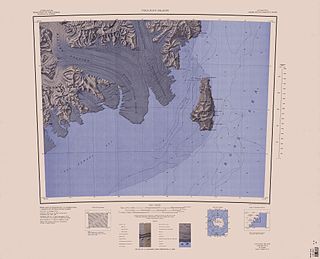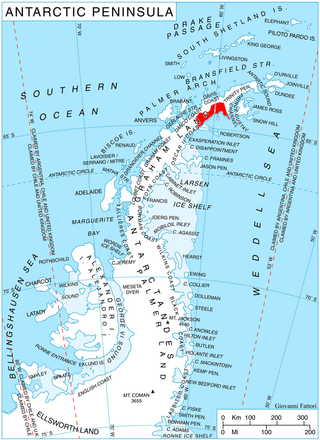
Borchgrevink Glacier is a large glacier in the Victory Mountains, Victoria Land, draining south between Malta Plateau and Daniell Peninsula, and thence projecting into Glacier Strait, Ross Sea, as a floating glacier tongue, the Borchgrevink Glacier Tongue, just south of Cape Jones. It was named by the New Zealand Geological Survey Antarctic Expedition, 1957–58, for Carsten Borchgrevink, leader of the British Antarctic Expedition, 1898–1900. Borchgrevink visited the area in February 1900 and first observed the seaward portion of the glacier.

Leppard Glacier is a large valley glacier draining east between the Aristotle Mountains and Voden Heights, and flowing into Scar Inlet north of Ishmael Peak, on the east coast of Graham Land, Antarctica. The glacier was first seen from the air and photographed in part by Hubert Wilkins on December 20, 1928, and was surveyed by the Falkland Islands Dependencies Survey (FIDS) in 1955. It is now clear that, on the photographic evidence of his outward flight, Wilkins gave the name "Crane Channel" to this glacier, and that on his return flight he photographed what is now accepted as Crane Glacier, perhaps thinking that it was the same feature. Since Crane Glacier has been retained for the northern of these glaciers photographed by Wilkins, the UK Antarctic Place-Names Committee has named this feature for Norman A.G. Leppard, assistant surveyor with the FIDS, who surveyed this area in 1955.
Detroit Plateau is a major interior plateau of Graham Land on the Antarctic Peninsula, with heights between 1,500 and 1,800 metres. Its northeast limit is marked by the south wall of Russell West Glacier, from which it extends some 90 miles (140 km) in a general southwest direction to Herbert Plateau. The plateau was observed from the air by Sir Hubert Wilkins on a flight of December 20, 1928. Wilkins named it Detroit Aviation Society Plateau after the society which aided in the organizing of his expedition, but the shortened form of the original name is approved. The north and east sides of the plateau were charted by the Falkland Islands Dependencies Survey in 1946–47.

Albone Glacier is a deeply entrenched narrow glacier on the east side of Wolseley Buttress flowing southward from Detroit Plateau on Nordenskjöld Coast in Graham Land, Antarctica.

Birley Glacier is a glacier, at least 10 nautical miles (19 km) long, flowing west into the eastern extremity of Barilari Bay north of Vardun Point, on the west coast of Graham Land. First seen and roughly surveyed in 1909 by the French Antarctic Expedition under Jean-Baptiste Charcot, it was re-surveyed in 1935–36 by the British Graham Land Expedition (BGLE) under John Rymill, and later named for Kenneth P. Birley, who contributed toward the cost of the BGLE, 1934–37.
Bolton Glacier is a glacier flowing into the head of Briand Fjord, Flandres Bay, on the west coast of Graham Land. It was mapped in 1959 by the Falkland Islands Dependencies Survey from photos taken by Hunting Aerosurveys Ltd in 1956–57, and named by the UK Antarctic Place-Names Committee for William B. Bolton (1848–89), English photographer who, with B.J. Sayce, invented the collodion emulsion process of dry-plate photography in 1864.

Breitfuss Glacier is a glacier 10 nautical miles (19 km) long, which flows southeast from Avery Plateau into Mill Inlet to the west of Cape Chavanne, on the east coast of Graham Land. It was charted by the Falkland Islands Dependencies Survey (FIDS) and photographed from the air by the Ronne Antarctic Research Expedition in 1947. It was named by the FIDS for Leonid Breitfuss, a German polar explorer, historian, and author of many polar bibliographies.
Bruce Plateau is an ice-covered plateau, at least 90 nautical miles (170 km) long and about 1,830 metres (6,000 ft) high, extending northeast from the heads of Gould Glacier and Erskine Glacier to the vicinity of Flandres Bay, in Graham Land. It borders Avery Plateau on the south and Forbidden Plateau on the north. The first sighting of this plateau has not been ascertained, but it was presumably seen in January 1909 by members of the French Antarctic Expedition under Jean-Baptiste Charcot from their position in Pendleton Strait. The plateau was mapped from aerial photographs and from Falkland Islands Dependencies Survey surveys, 1946–62, and named by the UK Antarctic Place-Names Committee after William S. Bruce, a Scottish polar explorer and leader of the Scottish National Antarctic Expedition, 1902–04.
Cayley Glacier is a glacier flowing northwest into the south side of Brialmont Cove, on the west coast of Graham Land.
Mount Walker is a snow-covered mountain which rises from the northeast part of Forbidden Plateau, 2 nautical miles (3.7 km) south of the head of Blanchard Glacier, in northern Graham Land, Antarctica. It was surveyed by Falkland Islands Dependencies Survey (FIDS) in 1955. Named by United Kingdom Antarctic Place-Names Committee (UK-APC) for Richard Walker of the Discovery Investigations, First Officer on RRS Discovery II, 1933–37.

Jorum Glacier is a glacier draining the southeast slopes of Forbidden Plateau, and lowing east into Exasperation Inlet, just north of Caution Point, on the east coast of Graham Land, Antarctica. It was surveyed by the Falkland Islands Dependencies Survey in 1947 and 1955. The UK Antarctic Place-Names Committee name alludes to the punchbowl shape of the head of the glacier, a "jorum" being a large drinking bowl used for punch.

Paré Glacier is a glacier 7 nautical miles (13 km) long and 1 nautical mile (1.9 km) wide, draining the northeast slopes of Stribog Mountains, and flowing east and then northeast into the head of Bouquet Bay on the northeast side of Brabant Island in the Palmer Archipelago, Antarctica.
Foster Plateau is a plateau, about 80 square miles (210 km2) in area, lying between Drygalski Glacier and Hektoria Glacier in northern Graham Land, Antarctica. It borders Forbidden Plateau on the south and Herbert Plateau on the north. The feature was photographed by the Falkland Islands and Dependencies Aerial Survey Expedition in 1956–57 and mapped from these photos by the Falkland Islands Dependencies Survey (FIDS). It was named by the UK Antarctic Place-Names Committee in 1960 for Richard A. Foster, FIDS leader of the Danco Island station in 1956 and 1957.
Green Glacier is a glacier on the east side of Graham Land, Antarctica, 15 nautical miles (28 km) long and 4 nautical miles (7 km) wide, flowing from the plateau northeast between Dugerjav Peak and Rugate Ridge, and then east into Vaughan Inlet next north of Pirne Peak and south of the terminus of Hektoria Glacier.
Herbert Plateau is a portion of the central plateau of Graham Land, Antarctica, lying between Blériot Glacier and Drygalski Glacier. It borders Foster Plateau on the south and Detroit Plateau on the north. The feature was photographed by the Falkland Islands and Dependencies Aerial Survey Expedition in 1956–57 and mapped from these photos by the Falkland Islands Dependencies Survey (FIDS). It was named by the UK Antarctic Place-Names Committee in 1960 for Walter W. Herbert, a FIDS assistant surveyor at the Hope Bay station in 1956 and 1957.
Slessor Peak is a mainly ice-covered peak, 2,370 m, standing at the southwest end of Bruce Plateau in Graham Land, close northwest of Gould Glacier. It rises about 300 m above the general level of the plateau ice sheet and has a steep rock face on its north side. First surveyed in 1946-47 by a Falkland Islands Dependencies Survey (FIDS) sledge party led by Robert S. Slessor, FIDS medical officer at Stonington Island, for whom the peak is named.

Laënnec Glacier is a glacier 3 nautical miles (6 km) long draining the northeast slopes of Stribog Mountains and the northwest slopes of Avroleva Heights, and flowing northeast into Hill Bay on the east side of Brabant Island, in the Palmer Archipelago, Antarctica.

Rozier Glacier is a glacier flowing between Pishtachev Peak and Balis Ridge into Wilhelmina Bay north of Sophie Cliff, on the west coast of Graham Land, Antarctica. Charted by the Belgian Antarctic Expedition under Gerlache, 1897–99. Named by the United Kingdom Antarctic Place-Names Committee (UK-APC) in 1960 for Jean-François Pilâtre de Rozier (1756–1785), French technician who made the first human balloon ascent and the first balloon voyage, in 1783.
The Forbidden Plateau is a long, narrow plateau extending southwestward from Charlotte Bay to Flandres Bay in Graham Land. It borders Bruce Plateau on the south and Foster Plateau on the north. The feature was mapped by the Falkland Islands Dependencies Survey (FIDS) from photos taken by Hunting Aerosurveys Ltd. in 1956–57. Its name was picked by the UK Antarctic Place-names Committee (UK-APC) because all attempts to reach the plateau failed until it was finally traversed by Falkland Islands Dependencies Survey (FIDS) members in 1957.
The Downfall is a mountain between the heads of Arago Glacier and Woodbury Glacier on the west coast of Graham Land. Mapped by the Falkland Islands Dependencies Survey (FIDS) from photos taken by Hunting Aerosurveys Ltd. in 1956–57. So named by the United Kingdom Antarctic Place-Names Committee (UK-APC) in 1960 because the feature marked the end of the route from Orel Ice Fringe by which members of the FIDS at Danco Island station had hoped in 1956 to reach Forbidden Plateau. A very steep drop on the east side of the summit precludes further progress.
![]() This article incorporates public domain material from "Wallend Glacier". Geographic Names Information System . United States Geological Survey.
This article incorporates public domain material from "Wallend Glacier". Geographic Names Information System . United States Geological Survey. ![]()






